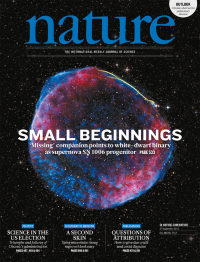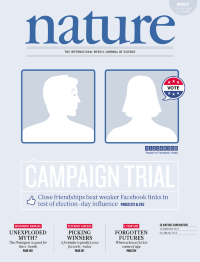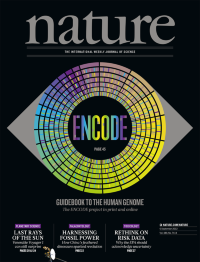Volume 489
-
No. 7417 27 September 2012
Type Ia supernovae are thought to occur in binaries containing a white dwarf and a companion that is a red giant, subgiant, main-sequence star or another white dwarf. In the last of these options, the double-degenerate� case, the two white dwarfs would merge before the explosion and no companion would be left. In a single-degenerate system the former companion star would survive. Previous searches for remnant companions have revealed one contested case for the Tycho Brahe supernova SN 1572. More recently, observations have restricted surviving companions to small, main-sequence stars, ruling out giant companions. Jonay González Hernández et al. report the result of a search for surviving companions to the progenitor of SN 1006 and find no sign of a former companion. Together with previous results, this suggests that fewer than 20% of type Ia supernovae occur through the single-degenerate channel, the slow accumulation of mass from a large star. The more common trigger, it seems, is the rapid break-up of a smaller orbiting white dwarf. The cover shows a composite image of the SN 1006 supernova remnant. A twisting ribbon of light seen by the Hubble Space Telescope reveals where the expanding blast wave is sweeping into the tenuous surrounding gas. (Cover: NASA/CXC/Rutgers/G. Cassam-Chena�, J. Hughes et al.; Radio: NRAO/AUI/NSF/GBT/VLA/Dyer, Maddalena & Cornwell; Optical: Middlebury College/F. Winkler, NOAO/AURA/NSF/CTIO Schmidt & DSS.)
Nature Outlook
-
No. 7416 20 September 2012
High-resolution maps of genome-wide gene expression have been available for mice for a few years, but only relatively coarse equivalents have been published for the human brain because of the challenges presented by the 1,000-fold increase in size and the limited availability and quality of postmortem tissue. Now Michael Hawrylycz and colleagues at the Allen Institute for Brain Science in Seattle, Washington, have used laser microdissection and microarrays to assess 900 precise subdivisions in brains from two healthy men with 60,000 gene-expression probes. The resulting atlas, freely available at www.brain-map.org, allows comparisons between humans and other animals, and will facilitate studies of human neurological and psychiatric diseases. One early observation from the data is a human-specific pattern � compared with the mouse and rhesus monkey � for the calcium-binding protein CALB1 in the hippocampus. Cover image: Allen Institute for Brain Science.
-
No. 7415 13 September 2012
Online social networks are everywhere. They must be influencing the way society is developing, but hard evidence is scarce. For instance, the relative effectiveness of online friendships and face-to-face friendships as drivers of social change is not known. In what may be the largest experiment ever conducted with human subjects, James Fowler and colleagues randomly assigned messages to 61 million people Facebook users on Election Day in the United States in 2010, and tracked their behaviour both online and offline, using publicly available records. The results show that the messages influenced the political communication, information-seeking and voting behaviour of millions of people. Social messages had more impact than informational messages and 'weak ties' were much less likely than 'strong ties' to spread behaviour via the social network. Thus online mobilization works primarily through strong-tie networks that may exist offline but have an online representation. Cover: Kelly Krause/Nature
Insight
-
No. 7414 6 September 2012
The ENCODE (Encyclopedia of DNA Elements) project aims to describe all functional elements encoded in the human genome. Nine years on from ENCODE's launch, its main efforts culminate this week in the coordinated publication of 30 papers, 6 of them in this issue of Nature. It has been a major undertaking and some of the lessons learned in setting it up could prove of value to others contemplating international collaboration. In a Comment piece, Ewan Birney, lead ENCODE analysis coordinator, explains how they did it. Cover by Carl DeTorres; Voyager image, NASA).




